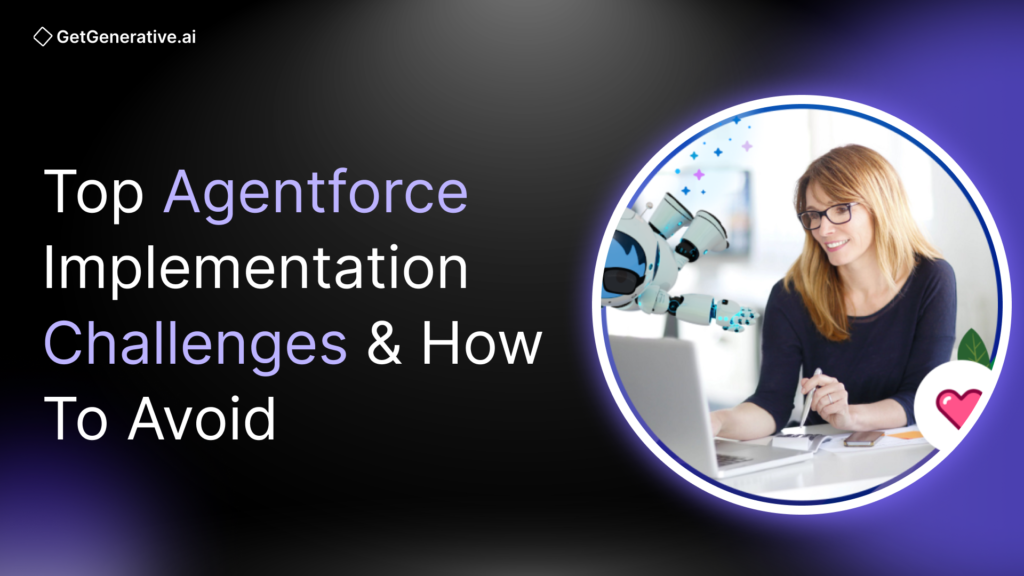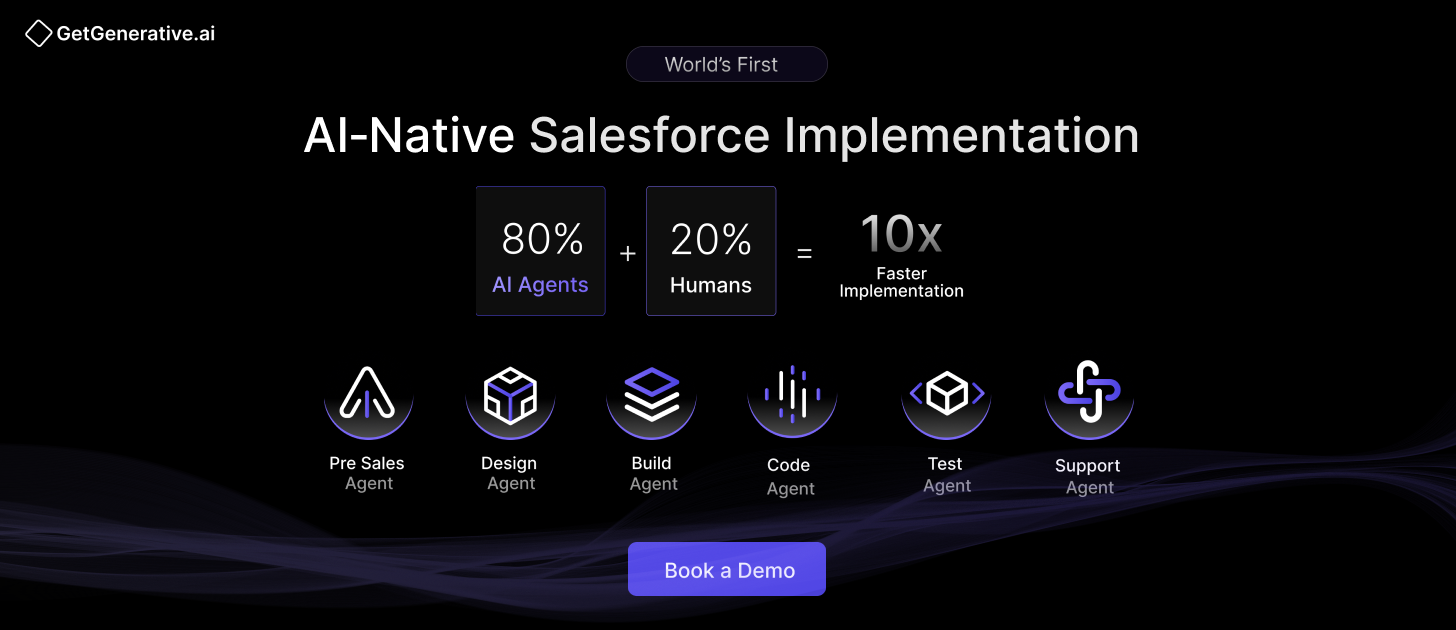Top Agentforce Implementation Challenges & How To Avoid
Salesforce Agentforce enables businesses to automate tasks, drive smarter decisions, and augment teams with intelligent digital agents. According to Salesforce, 83% of AI-enabled sales teams reported revenue growth, and 85% of AI-augmented service teams reduced costs—showcasing the platform’s transformative potential.
Yet beneath this potential lies a sobering truth: implementation is hard. Despite 5,000 Agentforce deals signed in early 2025 (3,000 paid customers, 2,000 trials), Salesforce CFO Amy Weaver described adoption as “modest”, citing slow rollouts and low near-term ROI.
The culprit?
Poor strategy, messy data, unrealistic timelines, and organizational resistance.
In this blog, we explore the top implementation challenges enterprises face with Agentforce—and most importantly, how to overcome them. Let’s get started!
1. Lack of Strategic Alignment and Clear Use Cases
The Problem:
Agentforce is not a plug-and-play solution. Many organizations jump in expecting the AI agents to “just work,” without defining specific business objectives. As a result, they automate low-impact tasks, misalign agents with KPIs, and see poor adoption. According to industry estimates, 80% of failed AI initiatives stem from misaligned goals and vague planning.
✅ The Solution:
Start with a business-led AI roadmap. Involve cross-functional teams—sales, service, marketing, IT—and ask:
- What exact processes do we want to optimize?
- What KPIs (e.g., case handle time, lead-to-opportunity ratio) should Agentforce impact?
- How will we measure success at each stage?
Use pilot programs to validate use cases, then scale those that move the needle. For example, instead of “improve service,” define a goal like “reduce claim resolution time by 25%” using Agentforce on top of Financial Services Cloud.
2. Poor Data Quality and Technical Debt
The Problem:
Agentforce relies on structured, high-integrity CRM data. Yet many Salesforce orgs carry years of technical debt—duplicate accounts, broken workflows, inconsistent picklists, and disjointed data sources. Garbage in, garbage out: AI can’t function effectively on untrustworthy information.
✅ The Solution:
Launch a data hygiene and governance initiative before implementation.
- Audit for duplicates, missing fields, and formatting issues
- Use Salesforce Data Cloud, MuleSoft, or ETL tools to unify fragmented sources
- Implement field validation rules, ownership guidelines, and metadata dictionaries
3. Weak Integration and Disconnected Architecture
The Problem:
Without integration into ERP, claims systems, contact centers, or external databases, Agentforce is flying blind. If an AI agent can’t access inventory, policy history, or transaction records, it produces irrelevant insights—or worse, incorrect ones.
✅ The Solution:
Design a unified architecture from day one. Use:
- MuleSoft for complex integrations
- Native Salesforce connectors for core apps
- Real-time API syncs with ERPs or data lakes
Ensure agents can access full 360° views: claims data, customer lifecycle, KYC, billing, etc. This approach ensures a context-aware agent, not a standalone chatbot.
4. Change Management, Training, and the AI Skills Gap
The Problem:
Without proper training, your team won’t trust—or use—Agentforce. Most admins haven’t mastered prompt engineering, AI behavior modeling, or Data Cloud mapping. Meanwhile, frontline users often feel threatened or overwhelmed by new tech.
✅ The Solution:
Roll out a structured, role-based enablement plan:
- Use Salesforce In-App Guidance and digital adoption platforms for contextual help
- Train admins in AI model tuning, prompt creation, and agent configuration
- Create “AI Champions” across departments to lead by example
- Run Q&A sessions on bias, privacy, and governance to ease fears
5. Confusion Over Pricing and ROI
The Problem:
Agentforce pricing models—$2 per external conversation, $75/user/month for internal use—can feel opaque. What counts as a “conversation”? When does the meter run? If you can’t forecast ROI clearly, CFOs won’t sign off.
✅ The Solution:
- Use Salesforce ROI calculators and dashboards from day one
- Track metrics like:
- Reduction in case handling cost
- Agent deflection %
- Increased lead conversion
- Educate finance teams on how pricing scales
- Run small-scale pilots and tie results to business metrics before scaling
Also Read – Why 92% of Salesforce Developers Are Using AI Coding Tools (And You Should Too)
6. AI Governance, Compliance, and Security
The Problem:
Agentforce deals with sensitive business processes and customer data—especially in finance and insurance. Without strong governance, the risks are real: leaking PII, violating GDPR/HIPAA, or surfacing biased recommendations. Worse, lax sharing rules in Salesforce can allow AI agents to “see” more than they should.
✅ The Solution:
Establish a formal AI governance framework before deployment. This includes:
- Role-based access controls for all agent behaviors
- Audit trails of agent actions and decision logs
- Guardrails using Salesforce’s Einstein Trust Layer (e.g., sensitive field filtering)
- Alignment with regulatory standards (GDPR, CCPA, HIPAA)
7. Over-Customization and Scope Creep
The Problem:
Agentforce is highly configurable—Flow, Apex, Slack actions, and more. But excessive customization creates tech debt, fragility, and bloated experiences. Enterprises often fall into the trap of building every requested feature or experimenting with all the shiny objects.
✅ The Solution:
Adopt a Minimal Viable Agent (MVA) strategy.
- Start with the simplest, highest-value use case (e.g., FAQ deflection)
- Build only what’s necessary to meet KPIs
- Use change request governance boards to vet any new feature additions
- Limit custom Apex unless there’s a measurable ROI
8. Unrealistic Timelines and Rushed Rollouts
The Problem:
AI isn’t magic—and Agentforce won’t transform operations in 30 days. Teams that rush go-live skip data prep, testing, or training phases. This results in rework, missed goals, and frustrated teams.
✅ The Solution:
Break the project into clear phases:
- Discovery: Use case validation, data audit
- Design: Architecture, security, prompts
- Build: Agent creation, integrations
- Test & Train: Sandboxes, walkthroughs, feedback loops
- Deploy: Staged rollout, analytics
- Improve: Ongoing tuning and governance
9. Lack of Post-Go-Live Governance
The Problem:
Once Agentforce is live, many teams disengage—no ongoing monitoring, no usage reviews, no prompt updates. Over time, the agents become outdated, irrelevant, or even inaccurate.
✅ The Solution:
Create a Center of Excellence (CoE) or agent governance board:
- Use Agentforce Analytics to track usage, success rates, and escalations
- Conduct monthly/quarterly audits of prompt logic and field dependencies
- Collect real-time user feedback (e.g., “Was this helpful?” prompts)
- Retire underperforming agents and update prompts based on changing business logic
10. Underestimating the Value of Expert Partners
The Problem:
Agentforce is a next-gen platform—it requires understanding of Salesforce AI Cloud, prompt engineering, secure data modeling, and experience in multi-cloud architecture. Many internal teams aren’t equipped to build it right the first time.
✅ The Solution:
Bring in certified Agentforce partners or consultants with industry experience. Look for:
- Salesforce AI + Industry accreditation
- Past success with similar orgs (e.g., Financial Services Cloud + Agentforce)
- Full-stack support (architecture + change management + training)
- Reusable agent templates and DevOps toolkits
Also Read – Getting Started with Code Builder and Agenforce in Salesforce
Final Thoughts
Agentforce is not a plug-and-play chatbot. It’s an AI-native operating system that, if implemented strategically, can unlock exponential gains. But the pitfalls are real. Enterprises must treat implementation as a transformation journey—not just a tool deployment.
At GetGenerative.ai, we’ve reimagined Salesforce implementation—built from the ground up with AI at the core. This isn’t legacy delivery with AI added on. It’s a faster, smarter, AI-native approach powered by our proprietary platform.
👉 Explore our Salesforce AI consulting services




